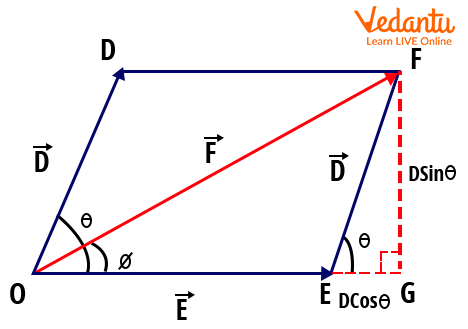




An Introduction to Vectors
A vector is a term which is coined to represent any quantity that has both direction and magnitude. It is taken after the Latin word where a vector means a Carrier. That means a vector needs to carry a quantity from one point to another. For example, if a vector is carrying a point D to a point E, then it is represented as
An important point to be noted is, that these vectors cannot be added algebraically that we use to generally add things in Mathematics. This ought to be added in a geometrical way where even the direction of a vector matters a lot. A vector is generally represented as an arrow with a head and a tail. To add these vectors, we use triangle and parallelogram laws of vectors and we call the result after adding it “Resultant”.
Let us understand and know the different ways adopted for the addition of two vectors.
Triangle Law of Vector Addition
This is a kind of vector addition where we adopt the triangle law. Triangle Law states that if there are two vectors named
Here, the vector represented by the line DF is the vector whose tail touches the tail of the

The Triangle Law of Vector Addition
So here, the magnitude of
Where d = magnitude of vector
e = magnitude of vector
If the angle between the resultant vector and the vector D is ɸ, then there is this formula stating the relationship between the angle
Parallelogram Law of Vector Addition
This is a kind of vector addition where the parallelogram law is used to add any two vectors. Therefore, Parallelogram law states that “If the two vectors are acting on a point at the same time wherein both of them in magnitude and direction are represented by the two sides of a parallelogram projecting from a point, then their resultant addition vector is represented by the diagonal of the parallelogram both in magnitude and direction.”
Let us demonstrate and understand this law.
Say,

The Parallelogram Law of Vector Addition
Parallelogram Law of Vector Addition Proof
As shown in Figure 2, the triangle OFG makes a right-angled triangle. To find the resultant OF, let’s apply the Pythagoras theorem for the triangle OFG.
I.e., (OF)2 = (OG)2 + (GF)2
From the figure, it is obvious that
Substitute these values in the above equation, and we will get
Therefore, OF can be written as
This is the magnitude of the resultant vector that we obtain after adding the vectors
To find the angle between the resultant and the vector
The above mentioned is the formula of parallelogram law of vector addition.
Note: The triangle and parallelogram law of vector addition in Mathematics is quite similar to the triangle law of forces and parallelogram law of forces in Physics. The triangle law of forces or the parallelogram law of forces uses the vectors which are represented as physical quantities called Forces.
Let us look into some solved examples on the triangle or parallelogram law of vector addition.
Solved Problem
1. There are two vectors of magnitude 3 units and 4 units between which the angle is 60o. Find the magnitude of the resultant vector using the triangle law of vector addition.
Solution: The magnitude of the resultant vector is given by the formula
Where |D| = 3 and |E| = 4 and the angle between D and E vectors is 60o
2. Given that the magnitude of vector D is 5 units and the magnitude of vector E is 7 units. The angle between the two vectors D and E = 30o. Find the angle between the resultant vector and E.
Solution: Given that |D| = 5 and |E| = 7 and
We know the relation from the above diagram in the article,
Therefore,
The angle between the resultant and the vector E is 17o
Conclusion
These laws of vector addition are used in various problems where the two vectors are to be added in Mathematics or Physics. Furthermore, the vector addition is commutative and associative as well. Generally, vectors are represented by the addition of three axes components in the XYZ plane. Here, the addition can be done normally as the vectors are represented in the coordinated system. Therefore, the laws of vector addition are demonstrated and proved with thorough apprehension.






FAQs on Triangle and Parallelogram Law of Vector Addition for JEE
1. Explain the law of vector addition and the limitations in choosing the type of vectors in addition.
The laws of vector addition are used to add two vectors which are having both the direction and magnitude. We have triangle law and parallelogram law to process the vector addition. Yes. We can’t add any two random vectors but only the vectors which are being added must have the same properties.
For example, any two displacement vectors can be added. But one displacement vector and one energy vector cannot be added as they don’t belong to the same category of quantities.
2. State parallelogram law of forces and also state the triangle law of vector addition.
Parallelogram law of forces states that if two forces acting at a point are represented as two adjacent sides of a parallelogram, then the diagonal of the parallelogram becomes the resultant of these two forces. The point to be noted here is the forces are represented as sides both in direction and magnitude.
If two vectors in a vector plane are represented both in magnitude and direction as the two adjacent sides of a triangle, then the third side of that triangle becomes the equivalent resultant after addition.












